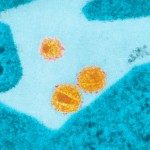Link to Pubmed [PMID] – 7888233
AIDS Res. Hum. Retroviruses 1994 Dec;10(12):1731-8
Analysis of the early stages of infection within the lymphoid organs is crucial for the understanding of the physiopathology of HIV infection. Such analysis can only be performed using animal models. Cats were infected with two strains of FIV and killed at regular intervals for a classic pathologic study along with a quantification of the viral load by in situ hybridization in the spleen and the lymph nodes. The pathological study showed a persistent follicular reaction, which peaked 15 days postinoculation (p.i.). The in situ hybridization study showed two types of labeling. The first was spot labeling corresponding to cells actively replicating the virus. The second consisted of a more diffuse labeling linked to the follicular dendritic cells (FDCs) demonstrating by colocalization of virus detected by in situ hybridization associated with the FDCs, specifically labeled by immunohistochemistry. The number of productive cells is few and identical for the two viruses tested. Despite a slight peak at 15 days p.i., the number of infected cells persists while slightly decreasing over time. The FDC virus load appears jointly with the appearance of antibody and remains permanent until the end of the study at 3 years p.i. These results show that in the FIV model, there is a chronic permanent infection in the lymphoid organs. Furthermore, as compared with the SIV-macaque model, there is a correlation between the low number of infected cells detected in these organs in the early phase and the extended length of the asymptomatic period, which contrasts with the high level of the FDC virus load lasting during the same period.
